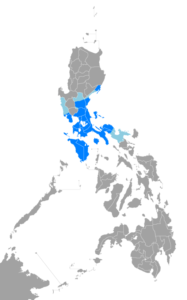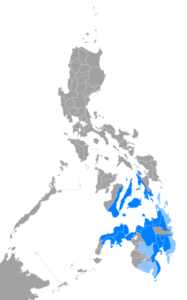“Should I learn Tagalog or Bisaya?” you ask yourself. Perhaps, you might also be asking whether you want learn “Filipino or Cebuano?”
On your journey to get closer to the Philippines (or maybe the heart of a Filipino or Filipina) through language, this is a decision you have to make early on.
This is a very common question, and to the outside, it can be a confusing one.
It’s time to end your paralysis by analysis. We lay down all the cards here.
- Why do so many people ask this question?
- Tagalog at a Glance
- Bisaya at a Glance
- “Should the language be called “Bisaya” or “Cebuano?”
- Where is Tagalog Spoken in the Philippines?
- Where is Bisaya Spoken in the Philippines?
- How are Tagalog and Bisaya related?
- How are Tagalog and Bisaya related?
- If I can understand Tagalog, can I understand Bisaya? (and vice versa)
- So, putting everything together… What should I be learning?
- Closing Thoughts
Why do so many people ask this?
People who want to learn the language of the Philippines often run into a choice of learning Tagalog and Bisaya.
Of course, the two official languages of the Philippines are Filipino and English. Because, the readers of TalkTagalog speak English, most of them will want to learn Tagalog.
But what is this “Bisaya” I keep hearing (sometimes referred to as “Cebuano”)?
(Note: we’re using the word “Tagalog” instead of “Filipino.” If you’re confused why, read our article: Filipino vs Tagalog vs Pilipino and More! – The Ultimate Guide on Understand Words Related to the Philippines)
Tagalog is the native language of over a quarter of the population, approximately 27 million people in the Philippines give and take. Bisaya is the native language of around 22 million people in the Philippines.
The dominance of these two language is clear. This next runner up with the most number of native speakers is Ilocano with about 8 million native speakers, followed by Hiligaynon/Ilonggo with around the same number of speak. From there, the other languages have drastically a lot less speakers.
With Tagalog and Bisaya being the two major Philippine languages, it’s no wonder they are often compared.
Tagalog at a Glance
You might already know what Tagalog is. (If not, read our article: What is Tagalog?)
Learning Tagalog for those dealing with people from the Philippines is self-explanatory. Most Filipinos can speak it natively or very well, probably around 60 million in a country of about 110 million people.
But, practically all people from the Philippines can speak Tagalog to some degree. Typically, only those lacking formal education can’t speak any Tagalog, because it is taught in school in the Philippines.
Bisaya at a Glance
Despite Tagalog being ubiquitous in the Philippines, you may hear suggestions to learn Bisaya. Next to English and Tagalog, Bisaya is the next most widely spoken. There are probably close to 20 million speakers of Bisaya.
The Bisaya comes from the Visayas, a cluster of islands in the center of the Philippines. The Visayas are one of three major geographical regions on the Philippines. The other two are Luzon in the North, and Mindanao in the South.
By the way, by no means are English, Tagalog and Bisaya the only languages of the Philippines. There are 120 – 187 languages spoken in the Philippines with 14 of these having more than million speakers each.
Should the Language be Called “Bisaya” or “Cebuano?”
You might be further confused by the word “Cebuano.” Is Cebuano the same as Bisaya? What’s the difference?
Cebuano refers to the language of Cebu. Cebu is the most prosperous and populous island in the Visayas region.
Because Cebu is such an economically important island in the Philippines, second in importance to the capital Manila, it’s no surprise some people may just refer to the Bisaya language as Cebuano.
Even Britannica’s website, the successor of the popular encyclopedia company, only has an entry on the Cebuano dialect, but doesn’t one on the Bisaya language.
While referring to Bisaya as Cebuano won’t probably won’t bother anyone, this is technically wrong.
There are several dialects of Bisaya. Cebuano Bisaya is just one of them. There is also for Boholano Bisaya (which my mother grew up speaking), Negrense Bisaya, Davaeño Bisaya and so forth. The differences to an outsider are very subtle, and all of the these dialects are mutually intelligible.
It is more correct to call the language as Bisaya, unless you’re specifically referring to the dialect that is spoken in Cebu island. If that’s not enough to convince you, most Filipinos refer to the language as Bisaya rather than Cebuano.
Where is Tagalog Spoken in the Philippines?
Tagalog, in a nutshell, is spoken in Manila and the southern part of the island of Luzon, and in nearby islands. Tagalog is the true lingua franca of the Philippines, and you’ll be able to find a Tagalog speaker practically anywhere in the archipelago.
For a full picture of where Tagalog is spoken, visit the article: Which Countries Speak Tagalog?

Where is Bisaya Spoken in the Philippines?
Bisaya is spoken in Central Visayas, the western part of Eastern Visayas, and in most of Mindanao.
In fact, until the 80’s Bisaya had more native speakers than Tagalog. The swelling of population in Metro Manila and its surrounding areas, skewed the number of Tagalog speakers.
Of course, there are lots of Bisaya-speaking communities and families around the Philippines and around the world.

How are Tagalog and Bisaya related?
Tagalog and Bisaya are quite closely related as languages go. If we are interested in how they are genetically related (I’m using word here ‘genetically’ as used Linguistics, not Biology as it’s more popularly used), we can see this.
Both Tagalog and Bisaya are both Austronesian languages. Austronesian languages came from Taiwan thousands of years ago. (Check out our article on Where did Tagalog Come From? – A Nerd’s History on Tagalog).
The two main branches of Austronesian are the Formosan languages, which stayed in Taiwan, and Malayo-Polynesian which spread out primarily to Southeast Asia, Polynesia, and interestingly Madagascar (as Malagasy).
Among the Malayo-Polnesian languages, are the Oceanic languages (Aloha, Hawaii!), Palauan languages, the Indonesian languages, and of course, the Philippine languages.
Among the Philippine languages are the various languages and dialects used in the Philippine archipelago. These range from Tagalog, the country’s lingua franca, to other major languages, like Hiligaynon/Ilonggo and Bisaya. There are also languages used only on certain islands and towns, and even tribal languages.
The Philippine languages have a subgroup ‘Greater Central Philippine’ languages that includes different subgroups like the Central Philippine languages (of which Tagalog and Bisaya are both members), Palawanic languages (languages of Palawan), Manobo languages in parts of Mindanao, and so on.
Tagalog and Bisaya are both Central Philippine languages which they share with
So linguistically speaking that’s the relation: Austronesian > Malayo-Polynesian > Philippine > Greater Central Philippine > Central Philippine.
That would be about as similar as Portuguese and Spanish.
Is Bisaya a Dialect of Tagalog?
It was previously taught in schools that in the Philippines that the main language was Tagalog, or more properly Filipino, and the other languages are dialects. Even, I was taught this as a schoolchild in the 80’s.
This thinking is pretty old-fashioned. Since then, there’s been a lot of linguistic study on the Philippine languages.
The way you distinguish languages from dialects is bit messy. For example, a common phenomenon is a dialect continuum or dialect chain. This is where dialects spoken across a geographical areas differ slightly from neighboring dialects. But at both ends of the chain, the “dialects” spoken are no longer mutually intelligible.
Despite this, linguists identify at least 120 distinct languages in the Philippine archipelago.
Calling Filipino (Tagalog) as the national language, and other “languages” like Bisaya, Ilocano and the others as “dialects” just doesn’t cut it. This was more of a political decision, or perhaps, just the linguistic ignorance of the day.
We know better now. Tagalog and Bisaya are separate languages.
The question is now, “If I understand Tagalog, can I understand Bisaya?”
If I can understand Tagalog, can I understand Bisaya? (and vice versa)
The level of understanding will be similar to how much a Spanish speaker can understand Portuguese.
A native Tagalog speaker will be able to get the general gist of what’s being spoken. A Tagalog speaker definitely won’t be able to understand everything, especially if Bisaya speaker is speaking very quickly.
Meanwhile, a Bisaya speaker will probably understand Tagalog very well. This owes to Tagalog being compulsory in school. Also, as one of the Philippines’ official languages (the other being English), a language used in mass media, and its use as lingua franca, a Bisaya speaker would have heard Tagalog spoken everywhere growing up.
So Putting Everything Together… Which Should I Be Learning?
If you want to learn to be able to talk to as many people from the Philippines as possible, learn Tagalog. Even those who don’t speak Tagalog natively will be able to converse in the language, including business people, government officials, and those who have a standard educational attainment in the Philippines.
There are many languages that act as regional lingua francas in the country, like Bisaya and Ilonggo. But Tagalog is the Philippines’ true lingua franca spoken from the northernmost to the southernmost tips of the archipelago.
However, if your intention is to settle in a Bisaya-speaking community, Bisaya will allow you to speak to people from all rungs in the ladder of society, from the uneducated fisherman to the town’s mayor. While almost all professionals will speak Tagalog, Bisaya will endear you to them.
Learning Bisaya over Tagalog will be a must in cases where the focus is inclusiveness in a Bisaya-speaking community, such as volunteer work dealing with indigents or uneducated community members.
Of course, you may want to learn Bisaya you aim to integrate yourself in a Bisaya-speaking family, or perhaps impress a Bisaya speaking spouse or loved one.
A Bisaya-speaking Filipino or Filipina will find a foreigner speaking Tagalog as impressive. However, a Bisaya-speaking foreigner is on an entirely different level of genius.
Overall, unless you have a specific reason to choose Bisaya over Tagalog, you’ll find many more opportunities to learn Tagalog.
Closing Thoughts
Choosing whether you should learn Bisaya or Tagalog boils down to what you want to accomplish.
If it’s a question of utility in the Philippines in general, Tagalog wins hands down.
However, not everything is a question of utility. Sometimes we just have a calling for a certain language. Being a language nerd, I am no stranger to this. I am sometimes attracted to learn certain languages or dialects because they hold a special meaning to us, even though the language is rarely spoken. For example, I am trying to learn the Chongqing dialect (spoken in a specific city in Western China and the countryside) and of Sichuanese Mandarin because I live in the city some years ago.
You’ll have your own reason why to choose one or the other. Maybe you met an attractive person who can speak Bisaya. Perhaps you heard your Filipino workmates chat in Tagalog which challenged to learn their language. Perhaps you are visiting Cebu and you want to watch jaws drop as you flatter locals in Bisaya.
No reason to learn one or the other is too silly or superficial. Both of these languages have over 20 millions of speakers, and they aren’t going away any time soon.

Can You tell me any GOOD Books to Learn BISAYA LANGUAGE please.
We Visayan people don’t need to learn Tagalog because we are more interested in learning the English language and besides that the people in Manila understand English. We are fine with our own dialect and don’t force it down our throats.
Tagalog dialect should only be reached in areas where they speak Tagalog and be deleted from the schools where Tagalog is not spoken.